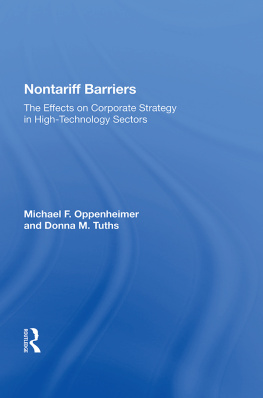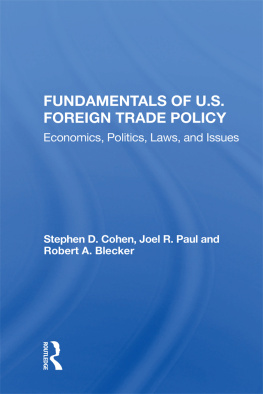About the Book and Authors
This book explores the impact of Japanese and European nontariff barriers (NTBs) on the international marketing, investment, and technology strategies of small- to medium-sized high-technology U.S. firms. The study documents a pronounced dichotomy between strategies of small and large companies that, to a significant extent, reflects the gap in the resources, bargaining power, and familiarity with foreign markets of these two groups. Conclusions concerning the efficacy of corporate strategies adopted are supported by an analysis of over 20 case studies. These strategies range from licensing agreements with local firms to use of a trading company or local distributor, formation of a joint venture with a local firm, and establishment of a wholly owned subsidiary in the foreign market.
Michael F. Oppenheimer is executive vice president at The Futures Group, where Donna M. Tuths is senior research associate in the International and Technology Section.
First published 1987 by Westview Press
Published 2018 by Routledge
52 Vanderbilt Avenue, New York, NY 10017
2 Park Square, Milton Park, Abingdon, Oxon OX14 4RN
Routledge is an imprint of the Taylor & Francis Group, an informa business
Copyright 1987 by the Futures Group
All rights reserved. No part of this book may be reprinted or reproduced or utilised in any form or by any electronic, mechanical, or other means, now known or hereafter invented, including photocopying and recording, or in any information storage or retrieval system, without permission in writing from the publishers.
Notice:
Product or corporate names may be trademarks or registered trademarks, and are used only for identification and explanation without intent to infringe.
Library of Congress Catalog Card Number: 87-050073
ISBN: 0-8133-7403-0
ISBN 13: 978-0-367-01401-8 (hbk)
The research for this book was conducted for the Office of Advocacy of the Small Business Administration in Washington, D.C., over an eleven-month period ending in September 1983. The basic objective of this study was to explore the impact of Japanese and European nontariff barriers (NTBs) on the international marketing efforts and investment and technology strategies of small- to medium-sized high-technology U.S. firms. Underlying this effort was the belief that NTBs have a greater impact on smaller firms than on larger ones because of the less-extensive international presence of most small businesses, their lack of sophistication in international trade matters, and the lack of resources such companies can devote to responding to NTBs.
Our previous work in this area convinced us that the most useful NTB research in support of trade policymakers is to provide detailed case histories describing the interaction of high-technology firms with the import regimes of our principal trading partners. The status of NTB data was reviewed in some detail in our previous work, wherein we found several NTB data bases of significant volume but lacking in timeliness, consistency, and detail. We were particularly determined to go beyond a simple inventory of NTBs to describe their workings at the company level, and to improve our understanding of the strategies that small- to medium-sized firms adopt in the presence of barriers to market entry. Thus, it is the interactions among market distortions, corporate strategy, and U.S. trade policy that occupy us in this report.
For purposes of this study, small- to medium-sized firms were identified by the Office of Advocacy as those companies whose total assets do not exceed $30 million. To determine the differential impact of these barriers, both large and small high-technology firms were interviewed so that the unique behavior of small firms would be highlighted. Over 25 percent of the case studies included in this report fall into the small- to medium-sized category defined by the SBA as appropriate for these high-technology sectors.
The process of identifying and eliciting case material from these firms proved a greater task than had been anticipated. A large number of the firms contacted were unwilling to participate in the study because they did not recognize nontariff barriers as suchbut rather considered the difficulties they encountered as legitimate aspects of doing business in an affected marketor because they recognized the existence of market distortions and their effect on firm behavior, but did not want to talk to the study team for fear of foreign government retaliation or of leaking important competitive information to other firms. As a result, case material was difficult to obtain.
In the process of this search, the study team conducted over seventy face-to-face interviews with individuals from industry, government, consulting, and various trade organizations. Several hundred leads produced by these efforts were followed up, resulting in the twenty-three cases discussed in this book. The companies interviewed encountered a wide range of market access problems. Among those, four main nontariff barrier types emergedstandards, performance requirements, government procurement, and patents. Discussion of these NTBs can be found at the end of each industry chapter immediately preceding the case material.
Not surprisingly, an analysis of the strategies adopted by small- to medium-sized firms and large firms in response to these market barriers revealed a pronounced dichotomy that, to a large extent, reflects the gap in the resources of these two groups. Large companies are more familiar with the intricacies of foreign markets and will not, in general, go to the U.S. government for assistance in penetrating a foreign market. These firms tend to have greater bargaining power in the foreign marketplace because of the large number of jobs and the size of the investment they can generate. Thus, large firms have a wider range of options available to counter market barriers. Smaller firms, on the other hand, generally do not have substantial export experience nor large sources of capital to invest in risky ventures. As a result, their options are greatly limited. By obtaining actual case study material, the study team gained useful insight into the different strategies adopted by these two groups.
Conclusions concerning the efficacy of corporate strategies adopted were apparent from an analysis of the case studies. These strategies ranged from licensing agreements with local firms, to use of a trading company or local distributor, formation of a joint venture with a local firm, and establishment of a wholly owned subsidiary in the foreign market. The case material revealed that some strategies were more prone to complications than others, regardless of the size of the firm implementing a given strategy. Overall, the licensing agreements encountered in this study did not prove to be effective over the long run. Companies found that the licensing arrangement was too difficult to control from a U.S. base. Consequently, the arrangement developed in an unwieldy manner and led to the licensees development of a competitive product which it would then sell directly into its domestic market.
On the whole, joint-venture agreements with local firms provided an effective means of penetrating a market blocked by preferential government procurement, standards problems, or significant performance requirements. These arrangements were found to be more stable over time if provisions for the transfer of technology and rights to the use of that technology by the joint-venture partners in world markets were narrowly defined in legal terms, and if the local partner was not a potential competitor of the U.S. firm.








